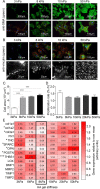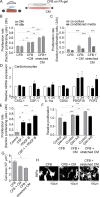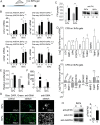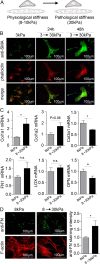Mechanical regulation of cardiac fibroblast profibrotic phenotypes
- PMID: 28468977
- PMCID: PMC5541838
- DOI: 10.1091/mbc.E17-01-0014
Mechanical regulation of cardiac fibroblast profibrotic phenotypes
Abstract
Cardiac fibrosis is a serious condition currently lacking effective treatments. It occurs as a result of cardiac fibroblast (CFB) activation and differentiation into myofibroblasts, characterized by proliferation, extracellular matrix (ECM) production and stiffening, and contraction due to the expression of smooth muscle α-actin. The mechanical properties of myocardium change regionally and over time after myocardial infarction (MI). Although mechanical cues are known to activate CFBs, it is unclear which specific mechanical stimuli regulate which specific phenotypic trait; thus we investigated these relationships using three in vitro models of CFB mechanical activation and found that 1) paracrine signaling from stretched cardiomyocytes induces CFB proliferation under mechanical conditions similar to those of the infarct border region; 2) direct stretch of CFBs mimicking the mechanical environment of the infarct region induces a synthetic phenotype with elevated ECM production; and 3) progressive matrix stiffening, modeling the mechanical effects of infarct scar maturation, causes smooth muscle α-actin fiber formation, up-regulation of collagen I, and down-regulation of collagen III. These findings suggest that myocyte stretch, fibroblast stretch, and matrix stiffening following MI may separately regulate different profibrotic traits of activated CFBs.
© 2017 Herum et al. This article is distributed by The American Society for Cell Biology under license from the author(s). Two months after publication it is available to the public under an Attribution–Noncommercial–Share Alike 3.0 Unported Creative Commons License (http://creativecommons.org/licenses/by-nc-sa/3.0).
Figures





Similar articles
-
Role of miR-145 in cardiac myofibroblast differentiation.J Mol Cell Cardiol. 2014 Jan;66:94-105. doi: 10.1016/j.yjmcc.2013.08.007. Epub 2013 Aug 31. J Mol Cell Cardiol. 2014. PMID: 24001939
-
Infarct Collagen Topography Regulates Fibroblast Fate via p38-Yes-Associated Protein Transcriptional Enhanced Associate Domain Signals.Circ Res. 2020 Oct 23;127(10):1306-1322. doi: 10.1161/CIRCRESAHA.119.316162. Epub 2020 Sep 4. Circ Res. 2020. PMID: 32883176 Free PMC article.
-
Reduced scar maturation and contractility lead to exaggerated left ventricular dilation after myocardial infarction in mice lacking AMPKα1.J Mol Cell Cardiol. 2014 Sep;74:32-43. doi: 10.1016/j.yjmcc.2014.04.018. Epub 2014 May 5. J Mol Cell Cardiol. 2014. PMID: 24805196
-
Myocardial fibroblast-matrix interactions and potential therapeutic targets.J Mol Cell Cardiol. 2014 May;70:92-9. doi: 10.1016/j.yjmcc.2014.01.008. Epub 2014 Jan 26. J Mol Cell Cardiol. 2014. PMID: 24472826 Free PMC article. Review.
-
Mechanical control of cardiac myofibroblasts.J Mol Cell Cardiol. 2016 Apr;93:133-42. doi: 10.1016/j.yjmcc.2015.11.025. Epub 2015 Nov 24. J Mol Cell Cardiol. 2016. PMID: 26620422 Review.
Cited by
-
Cardiac Remodeling and Ventricular Pacing: From Genes to Mechanics.Genes (Basel). 2024 May 23;15(6):671. doi: 10.3390/genes15060671. Genes (Basel). 2024. PMID: 38927607 Free PMC article. Review.
-
Culturing of Cardiac Fibroblasts in Engineered Heart Matrix Reduces Myofibroblast Differentiation but Maintains Their Response to Cyclic Stretch and Transforming Growth Factor β1.Bioengineering (Basel). 2022 Oct 14;9(10):551. doi: 10.3390/bioengineering9100551. Bioengineering (Basel). 2022. PMID: 36290519 Free PMC article.
-
Harnessing Mechanosensation in Next Generation Cardiovascular Tissue Engineering.Biomolecules. 2020 Oct 7;10(10):1419. doi: 10.3390/biom10101419. Biomolecules. 2020. PMID: 33036467 Free PMC article. Review.
-
3D matrix stiffness modulation unveils cardiac fibroblast phenotypic switching.Sci Rep. 2024 Jul 24;14(1):17015. doi: 10.1038/s41598-024-67646-x. Sci Rep. 2024. PMID: 39043765 Free PMC article.
-
Cardiac fibroblast sub-types in vitro reflect pathological cardiac remodeling in vivo.Matrix Biol Plus. 2022 Jun 6;15:100113. doi: 10.1016/j.mbplus.2022.100113. eCollection 2022 Aug. Matrix Biol Plus. 2022. PMID: 35719864 Free PMC article.
References
-
- Berry MF, Engler AJ, Woo YJ, Pirolli TJ, Bish LT, Jayasankar V, Morine KJ, Gardner TJ, Discher DE, Sweeney HL. Mesenchymal stem cell injection after myocardial infarction improves myocardial compliance. Am J Physiol Heart Circ Physiol. 2006;290:H2196–H2203. - PubMed
-
- Camelliti P, Gallagher JO, Kohl P, McCulloch AD. Micropatterned cell cultures on elastic membranes as an in vitro model of myocardium. Nat Protoc. 2006;1:1379–1391. - PubMed
MeSH terms
Substances
Grants and funding
LinkOut - more resources
Full Text Sources
Other Literature Sources
Molecular Biology Databases
Miscellaneous

